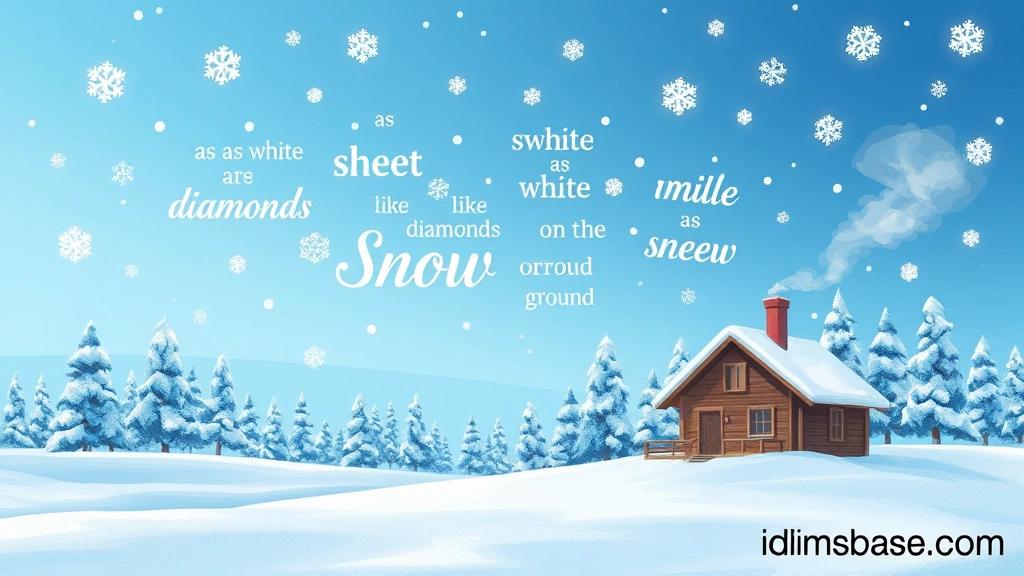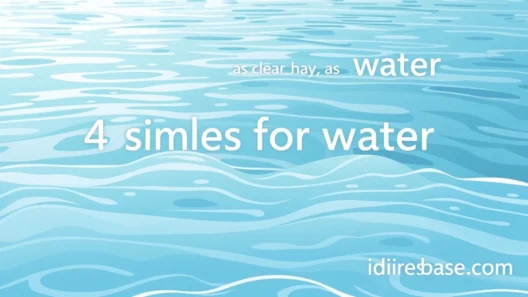Have you ever looked out your window on a winter morning and seen the world transformed into a glistening wonderland? That's the magic of snow! It blankets everything in a soft, pure white, changing the landscape in an instant. But how do you describe something so beautiful, yet so simple? That's where similes come in handy!
Similes are those wonderful literary tools that help us compare one thing to another, usually using "like" or "as." They paint vivid pictures in our minds and make our descriptions much more engaging. And when it comes to snow, there are so many ways to describe its unique qualities – its color, its texture, how it falls, and even its sound (or lack thereof!).
In this article, we're going to dive into a treasure trove of 40 amazing similes for snow. Whether you're a writer looking for inspiration, a poet searching for the perfect phrase, or just someone who loves the beauty of winter, you're in for a treat! Get ready to see snow in a whole new light.
Why Similes for Snow Matter
You might be thinking, "Why do I need 40 different ways to describe snow?" Well, every snowflake is unique, right? Just like that, every description of snow can be unique too! Using a variety of similes helps you:
- Create vivid imagery: Paint a clearer picture for your reader.
- Evoke emotions: Make your audience feel the scene.
- Avoid repetition: Keep your writing fresh and interesting.
- Show, don't just tell: Instead of saying "the snow was soft," say "the snow was as soft as cotton."
The Wonderful World of Snow Similes
Let's explore some fantastic ways to describe snow, categorized to help you find just the right comparison!

Similes Describing Snow's Appearance and Color
- As white as a ghost: For a slightly eerie, pure white.
- Like a blanket of diamonds: When it sparkles in the sun.
- As pure as a wedding dress: Emphasizing its pristine quality.
- Like powdered sugar: When it's light and fine on surfaces.
- As bright as a fresh sheet of paper: Highlighting its clean, stark whiteness.
- Like frosting on a cake: For thick, decorative layers.
- As dazzling as a thousand tiny mirrors: Reflecting light brilliantly.
- Like a fresh canvas: Ready for new footprints and adventures.
- As clean as a new slate: Suggesting a fresh start.
- Like spun sugar: For light, fluffy accumulations.
Similes Describing Snow's Texture and Feel
- As soft as a feather bed: For deep, yielding drifts.
- Like a down comforter: Warm and inviting in its appearance.
- As fluffy as cotton balls: When it's light and airy.
- Like velvet underfoot: For a smooth, quiet tread.
- As delicate as lace: For intricate snowflake patterns.
- Like fine sand: When it's dry and powdery.
- As slippery as ice: When it becomes compacted.
- Like a thick carpet: Covering the ground evenly.
- As light as dust: When it's very fine and easily blown.
- Like a mound of whipped cream: For soft, peaks and valleys.

Similes Describing How Snow Falls
- As silent as a whisper: When it falls gently.
- Like confetti: When flakes are small and numerous.
- As slow as molasses: For large, lazy flakes drifting down.
- Like tiny dancers: Twirling and swirling in the air.
- As steady as rain: When it falls consistently.
- Like a curtain falling: Obscuring the view.
- As thick as fog: When visibility is reduced.
- Like scattered pearls: For individual, glistening flakes.
- As fast as an avalanche: When it descends rapidly in a storm.
- Like floating dandelion seeds: Light and carried by the wind.
Similes Describing Snow's Impact and Sound (or Lack Thereof)
- As quiet as a grave: Muffling all sounds.
- Like a mute button: Silencing the world.
- As still as a painting: Creating a serene, unmoving scene.
- Like a magic spell: Transforming the landscape instantly.
- As cold as a witch's heart: Emphasizing its chilling effect.
- Like a sculptor's clay: Shaping drifts and mounds.
- As deep as a dream: When it piles up in vast quantities.
- Like a fresh start: Wiping away the old.
- As heavy as a wet blanket: When it's dense and difficult to move.
- Like a secret keeper: Hiding imperfections and blemishes.

Key Takeaways
- Similes use "like" or "as" to compare two different things, making descriptions more vivid.
- Using a variety of similes for snow enhances writing, creates imagery, and avoids repetition.
- Snow can be described through its appearance, texture, how it falls, and its overall impact.
- Choosing the right simile depends on the specific quality of snow you want to highlight.
Frequently Asked Questions (FAQ)
Q1: What is a simile?
A simile is a figure of speech that directly compares two different things, usually by using the words "like" or "as." It helps to make descriptions more vivid and relatable. For example, "The snow was as white as a ghost."
Q2: How do similes differ from metaphors?
The main difference is that similes use "like" or "as" to make a comparison, while metaphors state that one thing is another without using those connecting words. A simile says "The snow was like a blanket," whereas a metaphor would say "The snow was a blanket."
Q3: Why is it important to use varied descriptions for snow?
Using varied descriptions keeps your writing interesting and engaging. It prevents repetition and allows you to convey different nuances of snow, such as its softness, its sparkle, or how it affects sound, helping your reader visualize the scene more completely.
Q4: Can I create my own similes for snow?
Absolutely! The best similes often come from your own observations and creativity. Think about what snow reminds you of, considering its color, feel, sound, and how it moves. The more unique and personal your comparison, the more impactful it can be.
Q5: Are these similes only for writers or poets?
Not at all! While writers and poets certainly benefit from a rich vocabulary of similes, anyone can use them to enhance their everyday conversations or descriptions. They help you communicate more effectively and add a touch of beauty to your language, whether you're describing a winter scene to a friend or simply appreciating the view yourself.
So, the next time you see snow, don't just say "it's snowing." Challenge yourself to describe it in a new and exciting way! Use one of these similes, or better yet, invent your own. The world of words is yours to explore, and with these comparisons, you can paint a truly magical picture of winter's beauty. Which simile for snow is your favorite? Let us know!





